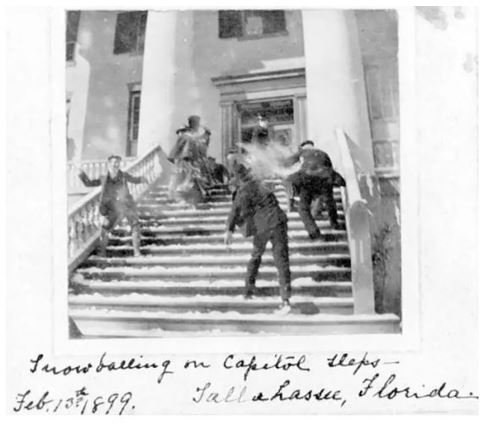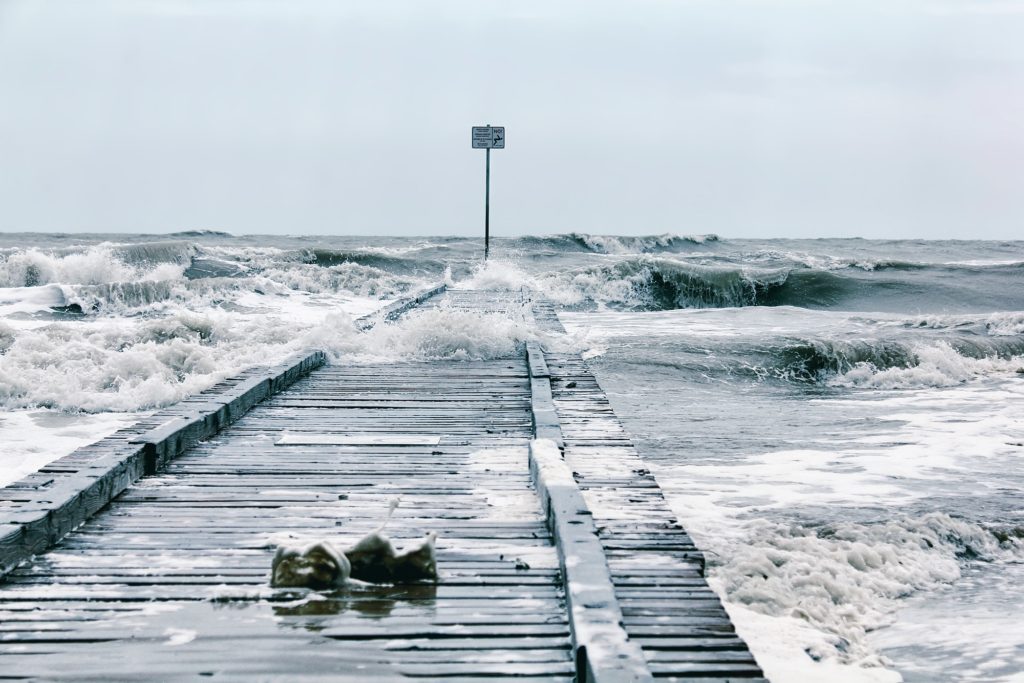Many winters have featured some very impressive surges of arctic air into the U.S. (1977 and 1985 come to mind immediately) but the most widespread and greatest arctic outbreak occurred during the first half of February in 1899.
The overall coverage of this outbreak was remarkably impressive. The cold impacted cities that are quite far south such as San Diego, California, and Fort Myers, Florida. Several state and city low-temperature records still stand. As you will see, the brunt of the cold extended from the Northwest and northern Plains southeastward to Florida.
The cold was so severe that the Mississippi River was frozen north of Cairo, Illinois. Large chunks of ice backed up the Mississippi River at New Orleans and some made their way down to the Gulf of Mexico. Ice jams along the Ohio River also triggered flooding.
In Chicago, Illinois the ground was frozen up to five feet below the surface. Water pipes and gas pipes burst all over the city. Plumbers used electrical currents to thaw the pipes.
There were forty-five states at that time and ALL of them recorded a temperature below zero during this event.
Weather historian Christopher Burt described this as “the greatest cold wave in modern U.S. history” in his book, Extreme Weather.
Event Timeline
There were some cold surges in January, particularly toward the end of the month but the “main event” occurred in February and some of the temperature statistics are “eye-popping”.
The Chief of Meteorological Records for the US Weather Bureau at that time was Alfred Henry. Here is his short summary of the event.
“Beginning with the first week in February, the most remarkable cold wave, or series of cold waves, in the history of the Weather Bureau traversed the United States from the north Pacific to the south Atlantic coasts, damaging crops and fruits in the Southern States to a very great extent. The lowest temperatures on record since the beginning of observations were recorded at a number of points in the North Pacific coast States during the first eight days of the month. From the 9th to the 12th of the month the coldest weather on record was reported at a number of points in the Central, Western, and Northwestern States. During the 13th and 14th, a cold wave overspread the Southern and Eastern States attended on the 13th by the lowest temperatures ever recorded at many points in the Southern and Gulf States
The initial surge of arctic air into the U.S. was during the first week of February. The Pacific Northwest became a virtual icebox as temperatures plummeted. Seattle, Washington, fell to 12 degrees while Portland, Oregon dipped to 9 degrees. The town of Usk, Washington recorded -36 degrees.
On February 4th, Idaho Falls, Idaho reported a low of -29 degrees. The lowest temperature recorded in Idaho was at Lost River at -41. Woodruff, Utah fell to -50 on February 6th and Salt Lake City bottomed out at -10. Lowell, Wyoming, dropped to -51 on the 4th.
California felt the bitter cold as Boca set a state record with -30 degrees. Los Angeles dropped to 33 degrees and it was 34 degrees in San Diego on February 6th.
In the Southwest, Flagstaff, Arizona recorded -21 degrees while Phoenix fell to 24 degrees. Windsors, New Mexico, fell to -27 on the 6th.
A winter storm produced some heavy snow in parts of the Northeast and Mid-Atlantic on February 7th and another surge of arctic air swept in behind it. I won’t dwell on the snow part of the story here but Washington, D.C. did receive 14 inches from three events.
Behind the winter storm, the next cold surge reared its ugly head from the northern Plains to the Gulf Coast as an arctic high (1040 millibars) moved from Canada southward into the U.S.
The Dakotas and Minnesota were already feeling temperatures below -3 degrees but the new surge dropped the temperature below -40. Wind chills in the northern Plains ranged from an astonishing -80- to -100 degrees!
Thousands of livestock perished during the great arctic outbreak of 1899. Photo Credit-Wikimedia Commons/Public Domain.
The most prolific surge of arctic air took hold from February 10th to the 14th as arctic high pressure (1055 millibars) pushed down from Canada. White River in Ontario fell to -54 degrees.
This surge, which came in two waves, took no prisoners as the cold front eventually pushed down through Florida and into the tropics. On the morning of February 10th, Easton, Wisconsin, shivered at -50 degrees. Milligan, Ohio plunged to -39 degrees, while Parkersburg, West Virginia set its all-time low at -33 degrees.
The second wave of cold air pushed down from Canada and into the U.S. as the “motherlode” surged southward with a 1064-millibar arctic high.
On February 11th, Washington, D.C. fell to -15 degrees and some outlying areas fell to -25. Lawrenceville, Pennsylvania reported a low of -39 degrees. Back to the west, Miles City, Montana fell to -47 degrees while Rapid City, South Dakota bottomed out at -34.
The HIGH temperature at Havre, Montana was -26 degrees. Wichita, Kansas, fell to -22 which remains its coldest temperature on record. The temperature fell below zero from northern Texas to Arkansas.
February 12th featured extreme cold, especially west of the Mississippi River. Camp Clarke, Nebraska fell to -47 degrees, Greely Colorado, recorded a low of -45, and Tuia, Texas, dropped to -23 degrees. Farther east, Woodstock, Vermont fell to -30.
Kansas City, Missouri dipped to -22 degrees while Oklahoma City bottomed out at -17. Dallas, Texas, reported an amazing low of -10 degrees and Galveston fell to 8 degrees. Galveston Bay was completely frozen over.
Along the Gulf Coast, temperatures fell into the teens and 2 to 3 inches of snow accompanied the cold. The low pressure in the Gulf responsible for the snow strengthened rapidly along the East Coast and there were significant snow and blizzard conditions from the Carolinas to New England.
Snowfall totals of 20 inches were recorded from Washington, D.C. to Philadelphia and at least 15 inches from New York City to Boston. Measurable snow fell in Tampa Florida and snow showers were reported all the way down to Ft. Myers as the frigid air plunged down through the Sunshine State. The temperature fell to below freezing in Miami.
Behind the coastal storm, the temperature crashed to inconceivable lows. Tallahassee, Florida fell to -2 degrees and Atlanta, Georgia recorded -9. Mobile, Alabama fell to -1. Incredibly, New Orleans had a low temperature of 7 degrees! Despite the cold, the Mardi Gras parade and festivities weren’t canceled.
French Camp, Mississippi dropped to -16 degrees. The cold front swept through Havana, Cuba, San Juan, Puerto Rico, and Bridgetown, Barbados.
The photo shows men engaged in a snowball fight in Tallahassee Florida on February 13, 1899. The temperature plunged to -2 degrees. Credit-Pinterest.com
In North Carolina, Highlands reported their coldest day on record with -19 degrees. In Tennessee, Erasmus dipped to -30.
On February 14th Columbia, South Carolina, and Raleigh, North Carolina fell to -2 degrees. Shaws Forks, South Carolina bottomed out at -11. Charleston, South Carolina reported a low of 7 degrees with a fresh snow cover.
 A surface weather map from February 14, 1899, shows arctic high pressure and a cold front down to the lower latitudes. Image Credit – U.S. Weather Bureau.
A surface weather map from February 14, 1899, shows arctic high pressure and a cold front down to the lower latitudes. Image Credit – U.S. Weather Bureau.
On February 15th, Riverton, New Jersey, dropped to -17 degrees but that was the end of the cold surges. High pressure moved off the Atlantic Coast that day and a return flow of milder air pushed in behind it. In fact, there was a considerable warm-up in the East following that final surge of arctic air. Within a week, the snow cover at Washington, D.C. (over 20 inches) had almost disappeared.
Adverse Impacts
Needless to say, a widespread and prolonged event such as this took a large toll on the economy. Over 100 people lost their lives as did literally thousands of animals, including livestock.
According to F.P. Chaffee of the Alabama Climate and Crop Service “stock suffered very much; in some counties cows, hogs and goats froze to death and poultry froze on the roost.”
Many trees didn’t survive the cold in the Midwest. The peach crop in Georgia was almost totally destroyed as was the Florida citrus crop.
Transportation came to a halt in many areas. In 1899, rail was still a chief mode of transport for goods and for people. Trains were stalled by cold and snow across parts of the nation. Shipping was severely hampered because many ports were cluttered with ice.
Ice jams on all of the major river systems in the Midwest (including Ohio and Mississippi) all but stopped any transport by shipping. Schools were closed in many states.
The photo shows residents of Edgard, Louisiana, watching chunks of ice flow down the Mississippi River in February of 1899. Photo Credit-Louisiana Historical Society.
Rivers, creeks, and streams across the South froze over, killing many of the fish that inhabited them.
Arctic outbreaks have been short and they have covered less territory in recent winters, Hopefully, we won’t see any outbreaks like this one again!







